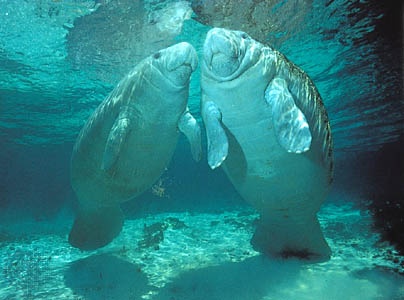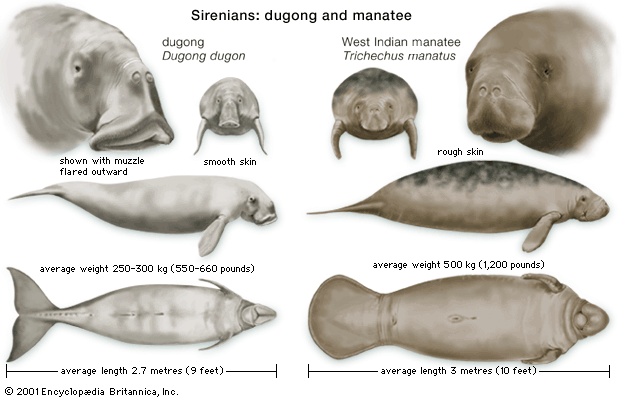manatee
mammal
Introduction
 any of three species of large, slow aquatic mammals found along tropical and subtropical Atlantic coasts and associated inland waters. Dull gray, blackish, or brown in colour, all three manatee species have stout, tapered bodies ending in a flat, rounded tail used for forward propulsion. The forelimbs are modified into flippers; there are no hind limbs.
any of three species of large, slow aquatic mammals found along tropical and subtropical Atlantic coasts and associated inland waters. Dull gray, blackish, or brown in colour, all three manatee species have stout, tapered bodies ending in a flat, rounded tail used for forward propulsion. The forelimbs are modified into flippers; there are no hind limbs.The Florida manatee (T. manatus latirostris), which is also found seasonally in the waters of nearby states, is one subspecies of the West Indian manatee (T. manatus). The other subspecies lives in nearshore waters, lagoons, estuaries, and rivers of eastern Mexico, down the Central American coast, and across northern South America. It also occurs around the Greater Antilles islands of the Caribbean—hence its common name, the Antillean manatee (T. manatus manatus).
The Amazonian manatee (T. inunguis) inhabits the Amazon River and associated drainage areas, including seasonally inundated forests. This species lives only in fresh water and can be found far inland through Brazil to Ecuador, Peru, and Colombia. The West African manatee (T. senegalensis), found in coastal areas and slow-moving rivers from Senegal to Angola, also ranges far inland in some rivers.
Form and function
 Florida manatees generally grow to around 3 metres (10 feet) but range in length from about 2.5 to 3.9 metres (8 to 13 feet) and weigh up to 1,655 kg (3,650 pounds). The Antillean subspecies is very similar but is distinguishable from the Florida manatee by certain skull features. West African manatees closely resemble West Indian manatees and are similar in size. Amazonian manatees are smaller, reaching a length of 2.8 metres (9.2 feet) and a weight of 480 kg (1,056 pounds), and, unlike the other two species, they are more blackish in colour, commonly have a white patch on the chest, and lack nails (nail) on the flippers. The flippers are used by all species for sculling, turning, bottom walking, and manipulating food.
Florida manatees generally grow to around 3 metres (10 feet) but range in length from about 2.5 to 3.9 metres (8 to 13 feet) and weigh up to 1,655 kg (3,650 pounds). The Antillean subspecies is very similar but is distinguishable from the Florida manatee by certain skull features. West African manatees closely resemble West Indian manatees and are similar in size. Amazonian manatees are smaller, reaching a length of 2.8 metres (9.2 feet) and a weight of 480 kg (1,056 pounds), and, unlike the other two species, they are more blackish in colour, commonly have a white patch on the chest, and lack nails (nail) on the flippers. The flippers are used by all species for sculling, turning, bottom walking, and manipulating food.Manatees are uniquely adapted for eating aquatic plants. The manatee's large lips are prehensile and studded with specialized sensory bristles and hairs (vibrissae) for discriminating between and manipulating food plants. Compared with the fish and krill eaten by other marine mammals, most aquatic plants are low in energy value and protein. Manatees must therefore eat large amounts of this bulky, low-energy food to satisfy their dietary requirements. To handle such a diet, manatees are hindgut digesters (like horses) and have intestines as long as 30 metres (100 feet). The teeth have also evolved in response to dietary demands. To counter abrasion from ingested sand and silica, manatees constantly grow new molars. These teeth progress from the rear of the jaws forward as older, worn teeth drop out at the front of the mouth. Unlike almost all other mammals, tooth replacement occurs throughout life.
The lungs are oriented parallel to the water's surface, and the ribs lack marrow, which makes them unusually dense and heavy. These traits, along with the manatee's ability to control the volume of small air spaces in the lungs, permit the animal to maintain a horizontal orientation anywhere in the water from the bottom to the surface. Manatees can remain submerged for up to 20 minutes. With each breath they replenish about 90 percent of the air in the lungs. (Humans, by contrast, replenish only about 10 percent.) This set of diverse adaptations enables foraging on a variety of plant forms, including submerged sea grasses, floating plants, mangrove leaves, and grasses along banks.
Manatees have unusually low metabolic rates, which probably makes possible their long fasting periods and subsistence on low-energy food. Although they can deposit large stores of fat, manatees' capacity to generate and retain body heat in cool water is poor. The brain is very small in comparison with those of other mammals of similar body size. Although the cerebrum lacks marked convolutions, the proportion of the brain devoted to higher functions is comparable to that of primates.
Natural history
Manatees are active day and night and can sleep submerged or while breathing at the water's surface. They are primarily solitary but form small transient groups for periods of hours or days. Aggregations of up to 20 males may form mating herds centred on a receptive female; other temporary aggregations may form at feeding areas, freshwater seeps, or warm water sources. During extreme cold spells in Florida, aggregations of 300 or more have been observed in the warm water outflows of power plants. Many Florida manatees also migrate southward during winter. Amazonian manatees migrate in response to water-level fluctuations associated with rainy and dry seasons. When surrounding waters recede, they can become isolated in pools but are able to fast for up to seven months in these situations by slowly metabolizing stored fat. Manatees, particularly mothers and calves, communicate by sound, producing faint underwater chirps, squeaks, and grunts. Manatees also engage in tactile contact by using sensory hairs scattered across the body, especially the hairs and bristles of the muzzle.
The Florida manatee is a symbol for conservation and an extremely popular animal with the public. Some wild manatees become accustomed to humans and will swim among snorkelers and anchored boats, seeking to be rubbed and scratched. Tourists and residents alike seek encounters with manatees in the wild or visit zoos and aquaria to view captives. Florida manatees have been the subject of much research, and most information on manatees is based on studies of this subspecies, but all manatees probably share many aspects of natural history.
Manatees are long-lived and reproduce slowly. Age estimates based on growth rings in ear bones indicate life spans of up to 59 years, and some manatees have survived more than 50 years in captivity. Females produce one calf every two to three years, with twins occurring rarely. Although they begin eating plants when very young, calves accompany mothers for up to two years, nursing from teats located at the base of the flippers. Sexual maturity occurs as young as three years, with gestation taking about a year or slightly longer. In Florida, reproduction occurs year-round, with seasonal birth and mating peaks in spring and lows in winter.
The manatee life cycle has important implications for the conservation of their populations. Records of predation on manatees are extremely rare, and the greatest source of mortality worldwide is humans. Although manatees are protected by law throughout their range, their numbers have diminished because their reproductive rates cannot keep pace with losses from hunting, drowning in fishing nets, and habitat degradation. In Florida, accidental collisions with motorboats and crushing in canal gates have replaced hunting as a major cause of death. Manatees have been used to control aquatic weeds in parts of their range, but in Florida this is no longer considered feasible because of the fast rate of plant growth in comparison to the number of manatees required for consuming them.
Evolution and paleontology
 Manatees are the only living members of the family Trichechidae, which is related to the dugong family, Dugongidae. Both families belong to the order Sirenia (sirenian). The fossil ancestors of modern manatees lived during the Miocene Epoch (23.8 million to 5.3 million years ago), when South America was isolated and the uplifting of the Andes Mountains caused a flourishing of aquatic vegetation, including grasses. The abrasiveness of these plants provided selection forces favouring the unusual manatee tooth-replacement pattern. When manatees returned to the sea about a million years ago, their superior teeth probably made it possible for them to prevent ancient members of the dugong family from becoming established in the Atlantic.
Manatees are the only living members of the family Trichechidae, which is related to the dugong family, Dugongidae. Both families belong to the order Sirenia (sirenian). The fossil ancestors of modern manatees lived during the Miocene Epoch (23.8 million to 5.3 million years ago), when South America was isolated and the uplifting of the Andes Mountains caused a flourishing of aquatic vegetation, including grasses. The abrasiveness of these plants provided selection forces favouring the unusual manatee tooth-replacement pattern. When manatees returned to the sea about a million years ago, their superior teeth probably made it possible for them to prevent ancient members of the dugong family from becoming established in the Atlantic.Today's West Indian manatee has changed little compared with its ancestors of the past few million years. The West African manatee is also similar to the ancestral forms and may have dispersed from South America to Africa via transoceanic currents. Amazonian manatees appear to be descendants of Miocene trichechids isolated in a closed interior basin of South America.
Additional Reading
John. E. Reynolds III and Daniel K. Odell, Manatees and Dugongs (1991), is a substantive and well-illustrated account of the biology and conservation of dugongs and manatees. Thomas J. O'Shea, “Manatees,” Scientific American, 271(1):66–72 (July 1994), provides information on the evolution, biology, traditional significance, and conservation problems of manatees. Warren Zeiller, Introducing the Manatee (1992), a firsthand account of manatee experiences from a former curator of the Miami Seaquarium, also includes coverage of other sirenians. The Best of Manatees (1991), produced by David Clarke, is a documentary available on videotape.
- Valery Borzov
- Valery Brumel
- Valery Bykovsky
- Valery Kubasov
- Valery-Nicolas Larbaud
- Valery Vladimirovich Polyakov
- Valery Yakovlevich Bryusov
- Valhalla
- Valignano, Alessandro
- Valindaba
- valine
- Valium
- Valkyrie
- Vallabha
- Vallabhbhai Jhaverbhai Patel
- Vallabhācārya
- Valladolid
- Valladolid, University of
- Valla, Lorenzo
- Vallandigham, Clement L
- Valle Central
- Valle d'Aosta
- Valle de la Pascua
- Valle del Cauca
- Valledupar